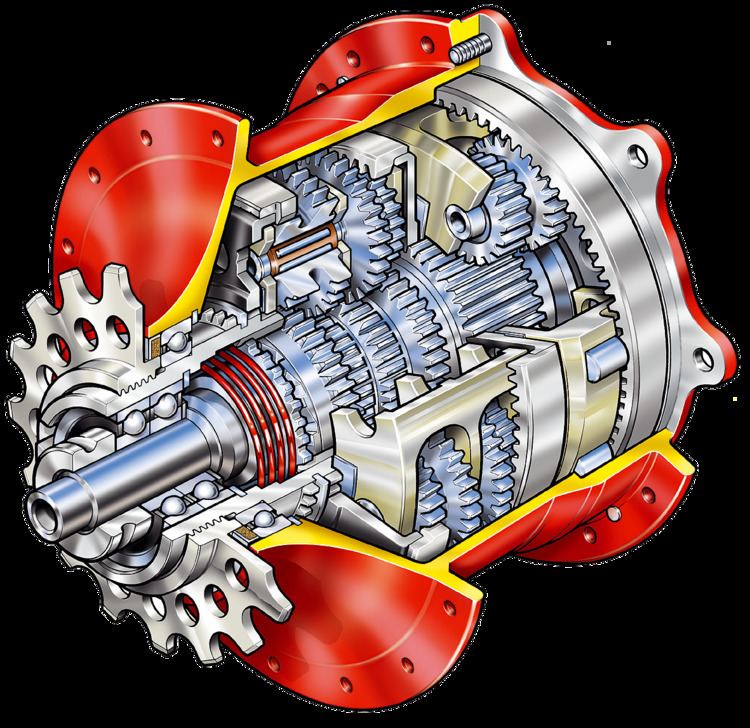 | ||
The Rohloff Speedhub is an epicyclic internal hub gear for bicycles, developed and patented by Rohloff AG. It has been manufactured and marketed by that company since 1998. The Speedhub 500/14 has 14 equally spaced sequential non-overlapping gear ratios operated by a single twistgrip. The overall gear range is 526%, meaning the highest gear is 5.26 times as high as the lowest gear. Individual gear shifts when shifting up give an increase of about 13.6% (equivalent to a decrease of about 12.0% when shifting down).
Contents
The Speedhub is more expensive than competing bicycle gear systems (both hub gears and derailleur gears), and it is about 500 to 1,000 grams heavier than a set of derailleur gears, but it offers the gear range of derailleur gears (and at its ratio of 5.26:1 more range than a typical road bike ratio of 4.28:1 with 50/34 chainrings and 11 to 32 tooth cassette) while requiring significantly less maintenance and having a longer service life. It is therefore mainly used in expensive touring bicycles and in mountain bikes, where its lack of (vulnerable) external components is useful.
Versions
There are different options available for the Speedhub to cater for different kinds of bicycle frames and applications that the bicycle it is to be fitted to might be used in.
Either of the above comes with the following three options:
There also two types of axle available:
As of 2014, the Speedhub is available in three colours: silver, red or black.
Finally, the Speedhub is available with either 32 or 36 spoke holes.
The above options are combined so a particular unit could be a Speedhub "CC DB OEM2 silver, 32 spoke holes" or a Speedhub "TS EX OEM black, 36 spoke holes" for example.
Operation
The internal construction of the gear hub consists of three planetary gear series, connected one after the other, selectively engaged depending on the user’s gear choice, each comprising a stepped planet. The first two gear series provide seven ratios, and the third a complete range reduction, doubling the number of speeds to fourteen. The first two stepped series are identical and mirrored, each offering two ratios and direct drive. Each planet level meshes with a sun gear, and each smaller planet meshes with an annulus. Shifting is achieved by locking each sun in turn, using pawls, and locking the first and second series to direct drive with an axial clutch. The first planetary series gears three and two steps up respectively, while the second gears two and three steps down respectively, both also having direct drive. One step up is achieved by combining three steps up with two steps down, and one step down by combining two steps up with three steps down. Thus three different steps up, direct drive and three different steps down is achieved by a double planet system, all in even increments due to the cog sizes selected. The reduction gear is a standard unit known from the art.
The IGR, hub revolutions per sprocket revolution of the Speedhub, lies between 0.279 and 1.467 depending on the gear chosen. The Speedhub has a 526 % range between the highest and lowest gear. Gear 11, with a ratio of 1.0, is called the neutral gear.
The overall average loss of the gears is about 1 %–5 %, comparable to a derailleur.
The range of gears in detail is:
Mounting
The Speedhub is provided with a twist shifter for shift operation, with one cable pulling in each direction. The indexing mechanism is part of the hub. In 2016 the Bpod psh'R, a hydraulic MTB lever and integrated road shifters for the Rohloff hub were announced. The new shifters allow for more convenient mounting, especially on road bars. The hydraulic feature alleviates some of the issues with traditional cable systems, such as friction and cable tension.
As with all hub gears, there is a torque reaction that must be countered if the internals are not to rotate, and this is routed to the bicycle’s frame by means of specially designed wheel dropout slots (OEM versions), or a torque bar bolted to the frame (EX) or the disc brake mount (DB).
The hub contains 25 ml of oil which should be replaced once a year or after 5,000 km (manufacturer advice). Overfilling can lead to leaks, as can laying the hub/cycle on its side in some low-pressure aircraft holds.
The sprocket on the hub is made for standard-pitch derailleur-type bicycle chains 1/2″ × 3/32″ (ISO 082) and is offered with different numbers of teeth, like 13/15/16/17. The 15-, 16-, and 17-tooth sprockets are reversible, offering double sprocket life once the sprocket is worn out in one direction. The 13-tooth sprocket is non-reversible and has a 4 mm outward offset, changing the chain-line from 54 to 58 mm, this because the smaller sprocket makes the chain run closer to the axle, and the chain would rub the hub shell if the sprocket were not offset.
Break-in period
Rohloff hubs generally require a break-in period to function optimally. The manufacturer suggests this may require 500–1000 miles of active riding. For some riders the break-in period may be longer. Until the hub is broken in the rider may experience some noise or vibrations when the reduction-gear is in operation (gears 1–7).
